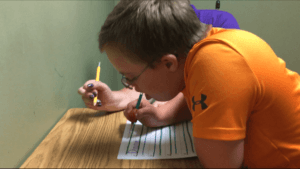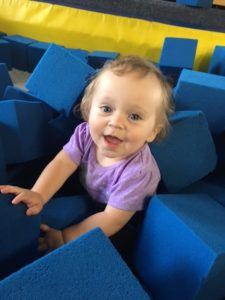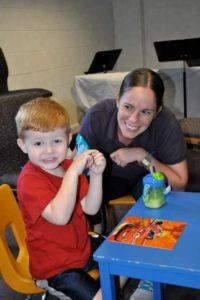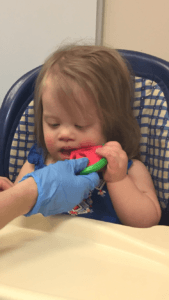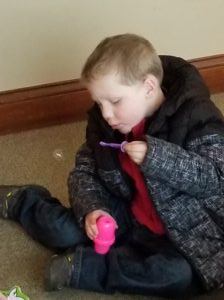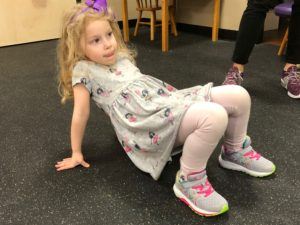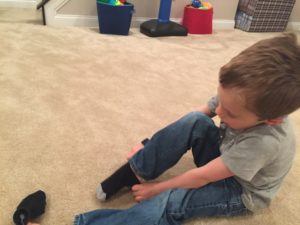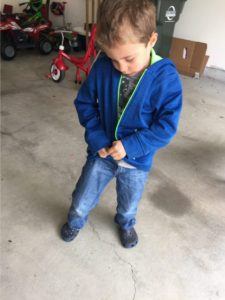Month: May 2017
Why Can’t My Child Do It? It’s Just Handwriting!
Children become very good hand writers by developing muscle strength, problem solving skills and eye hand coordination. A child who does not have the necessary skills that are developed before handwriting (i.e. arm strength, eye-hand coordination, letter and shape perception) will eventually struggle to complete such tasks at school and home.

The following problems may be present in a child who has difficulty with handwriting: -Limitations in trunk movement and control -Poor use of both arms/crossing the middle of the body -Limitations in range of motion (ROM), strength, and muscle tone of the hand and wrist -Poorly graded movements (control of the speed of movement) -Limitations in the ability to smoothly form basic strokes such as circles and lines -Difficulty with letter perception (recognition of forms, similarities and differences) -Challenges with visual-motor integration (using eyes and hands together) -Difficulty orienting to printed language (letter/word/sentence formation) -Challenges with position in space (knowing where you are in space)
Challenges with handwriting may impact child’s life in more than one area. The child may fall with their grades and begin to act out within the classroom and at home. This “acting out” may be used to avoid the challenge handwriting tasks present to the child. He or she may also struggle with lower self-esteem because he/she may not feel confident in comparison to his or her friends.
Occupational therapists work with the child and family in order to develop handwriting skills. The goal of therapy is to maximize the child’s skill level and facilitate that use of effective strategies to minimize frustration and increase accuracy. OT’s are able to target each and every problem area associated with poor handwriting and integrate these skills into play-based therapy activities that will strengthen the child’s deficulties and improve their handwriting.
***Handwriting Tip: When learning letters, have a child form the letters with play-dough instead of writing it. Not only is it more fun for them, but it also develops fine motor skills needed for proper handwriting. ***
If you have concerns with your child’s handwriting, please reach out to your pediatrician. Occupational Therapists (OTs) at https://www.abcpediatrictherapy.com would love to help you to help your child improve handwriting skills.
Read MoreThe best way to encourage communication in your 12 – 18 month old is to talk to him/her all the time.
Use your child’s name often so they learn to recognize who they are. 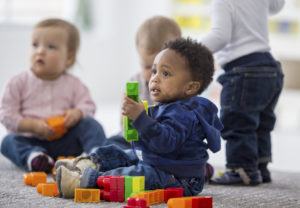
Ask yes / no questions so your child can begin to discriminate between yes and no and better understand when they are told “no”.
Help your toddler to understand simple instructions by making requests of them like “shoes in cubby” or “drink on table”.
Ask your child what they want and encourage them to point to the object. At this age, your child should be pointing to make their wants and needs known. Be sure you give words to what they are pointing to so they learn the words. Then encourage your child to repeat what you said. Your child should be able to imitate you. Your child should be able to say “mama” and “dada” and other familiar people and object names by this age.
Play fun games like Pat–a-cake and be sure to wave and encourage your child to wave bye-bye. Ask your child to point to body parts. Make sure you name each body part so that your child can learn the words to use. Make animal sounds. Books with real photos of animals are a great at to practice this skill. Animal sounds teach the sounds a child needs to say words. So practice animal sounds with your child.
Your child should begin to show a sense of humor at this age. Tickle them and tease them so that they see you laugh and learn to laugh as well.
At this age your child should play well on their own. He or she will not be good at sharing and will make it clear when a toy is “mine”. This is ok as your child is developing independence and self confidence.
Remember your child learns best by imitating so encourage all around him/her to interact often.
If your child is not picking up on the above skills after encouraging them for a couple months, please reach out to your pediatrician and share your concerns. ABC speech therapists love to teach parents how to encourage language in their children. Speech therapists can work with your child as well to help them get to their peer level. Visit our website https://www.abcpediatrictherapy.com for tips and tricks to help your child.
Read More
Eating and drinking between the ages of 2 and 3 can be tricky. Your child is looking for ways to exert their independence and food can often be a way to do that. Some ideas that might help minimize this power struggle might be helpful.
Allow your child to help you make the grocery list or go grocery shopping with you. Have your child choose what is for dinner by giving them 2 choices. “Should we have corn or green beans tonight?” When cooking and serving, verbally remind your child that you are proud of them for shopping for, choosing and now eating the vegetable they picked for dinner. You are reminding your child that they already had the control and planned the dinner. Hopefully, this will give you success at the dinner table.
Be flexible with messes at the table while you are teaching independence. Food is easily wiped up. Allow your child to serve themselves and model appropriate portions for each serving. Use a small pitcher for your child to pour their own drink while they are learning this skill. The confidence your child will develop around food will be pay off for your patience with the messes while learning.
Between the ages of 2 and 3 years of age, your child will:
· Eat the same foods as the rest of the family
· Feed himself well with a spoon and fork
· Have definite food likes and dislikes
· Refuse certain foods
· Possibly start to become a “picky eater”
· Wipe his own mouth and hands with a napkin or cloth
· Start to serve herself at the table with some spills
· Pour liquids into his cup from a small container
If your child is struggling learning the above skills, practice for a couple months. If behaviors are starting to develop, reach out to your pediatrician for guidance. At ABC, we want to be able to help before the behaviors cause too much upset. Learn more at https://www.abcpediatrictherapy.com.
Read MoreWhat are the eating and drinking skills of your 2 year old?
Review the list below and see if you need to provide more or different food opportunities to your child.
By 24 months (2 years), your child will:
· Swallow well from a cup with good lip closure around cup and no loss of liquid
· Swallow food well with good lip control and no loss of food
· Chew with jaw movements that go round and round, as well as up/down and side to side
· Know the difference between food and non-food items
· Scoop foods with a spoon, with some spills
· Start to stab food with a fork and get it to her mouth
Start to show clear likes and dislikes of some foods
How did your child do? If they are right on track, good job! You encouraged your child’s eating skills well. If your child has not mastered all of the above skills, do not worry. Now you are more educated on what to encourage when eating and drinking. Spend the next couple months encouraging your child to use their mouth muscles to eat and drink well. Encourage your child to only eat appropriates items – food versus nonfood items.
Be sure to encourage your child to use a spoon on their own. Praise their successes! Do not point out spillage.
Offer a fork and model how to use one.
Offer a variety of foods. It is ok to dislike some foods as long as you try everything. Be careful accepting too many foods that your child will not eat. This then becomes a controlling behavior. Offer your child control in other areas of their live….pink socks or white socks. Red shirt or blue shirt? Or give your child a choice in the vegetable for dinner. However, be sure to let your child know that all of the vegetables that you bought have to be eaten this week. They just get to pick which day each is eaten.
Reach out to your pediatrician for advice if your child does not reach the above milestones. Visit https://www.abcpediatrictherapy.com for more information on how we can help.
Read MoreSocially and nutritionally it is important that your child develop good eating and drinking skills. Early on when your child is first trying foods you need to offer a variety. Do not accept that they will only eat a few varieties. You need to be sure to offer sweet, sour and tangy foods. Offer a variety of textures (chewy, crunchy, liquid) and food with different levels of difficulty to eat. You do not want to develop a picky eater!
Early on your child is developing food skills that will effect them socially. Imagine going to a birthday party and not liking pizza. Or attending a baseball game and you won’t eat a hot dog. Maybe your child refuses to eat popcorn at the movies. Obviously, in today’s world there are other choices to eat but your child is missing out on enjoying varieties of food. Sleepovers can become awkward when there are limits on food choices. Do your best to encourage your child to like a large variety of foods.
Review the below list of skills and compare to your child’s skill level when eating.
Between 12-18 months, your child will: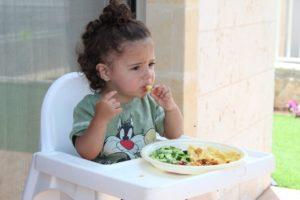
· Eat ground, mashed, or chopped table foods (including soft pieces of meat) by 15 months
· Use her tongue well to move food from side to side in the mouth
· Lose a bit of food or saliva out of the mouth while chewing
· Bite foods well
· Eat coarsely chopped table foods, including meats and raw vegetables by 18 months
· Sometimes chew with lips closed
· Drink from a cup well without losing liquid out of her mouth by 18 months
· Feed herself using a spoon, dropping some food off the spoon
· Start to refuse some foods
How did your child do? If your child needs some experience trying to improve a few of the skills above, work on encouraging those skills for about 2 months. If you find your child is not improving, ask your pediatrician for some help. At ABC, Speech Therapists and Occupational Therapists can help your child. Visit https://www.abcpediatrictherapy.com for more information.
Read MoreTry the checklist below for your child:
BY 60 MONTHS, can you child:
- Use a variety of sentences with 6 or more words

- Has a vocabulary of 2000 or more words
- Uses most speech sounds correctly (exceptions: th, r, r blends)
- Is 90-100% intelligible to all listeners
- Can describe objects and carry a plot when telling a story
- Asks questions to get more information
- Can follow multi-step directions without repetition
Language skills are important for a child to be able to express their wants and needs. Confidence is heavily influenced by a child’s ability to interact socially with their peer group. If a child struggles to find words or pronounce words, he/she may shy away from interaction with friends or express their opinion less in a group.
How can you help? Read books to and with your child. Name everything in their world. Increase the words your child knows by being as specific as possible. For example, do not call all shoes shoes. There are boots, flip flops, sandals, heels, slippers and many more ways to describe footwear.
Use adjectives and adverbs when talking to your child and encourage them to do the same. For example, “the tree” could be said “the big, green tree with the gnarly branches”.
Ask questions that require your child to give you more details. The questions will require your child to think of details and words to describe what he/she wants to say. For example, “what was the boy wearing?” or “what happened at the party?”.
Do not correct your child when they pronounce something wrong. Just restate what they said modelling the correct pronunciation.
Make sure to allow your child to have their own voice. Do not speak for them or the will not have the opportunity for others to understand them.
Be sure to challenge your child with multiple step directions and require they listen and follow the steps.
Remember to praise success! Keep encouraging your child to try and try again. You do not want your child to be afraid to fail. So keep encouraging.
If you try encouraging the above skills with your child for a couple months without success, ask your pediatrician for help. Speech therapists at https://www.abcpediatrictherapy.com love to encourage speech and language in children and teach parents to do the same.
Read More
Three is a pretty important age. So many skills are being established as the foundation for others skills to build upon. Your child is becoming more social, making friends. It is important that children increase the number of words they know as well as practice these words. Practicing saying words increases their ability to be understood by others (intelligibility).
Take a look at the checklist below. How is your 3 year old doing with these skills? Then review the tips to encourage these skills.

- Is 75% intelligible to all listeners
- Converses in sentences
- Has vocabulary of 1000 words
- Can tell a story
- Name one or more colors correctly
- May have pronoun confusion (ex her/she) and verb tense errors
- Follows prepositional commands and can follow three simple verbal commands
- Ask questions
- Responds to Wh- questions
Here are some tips to encourage the above skills:
- Make sure you name everything in your child’s world. Use lots of words. Nouns, adjectives, verbs.
- Require that your child try to name everything and model the word for them if they struggle then ask your child to try again. Praise all their efforts.
- Begin teaching words with 1 word sentences progressively adding words as your child becomes successful. Example: “dog” progress to “big dog” then to “the big dog” then to “the big brown dog” then to “the big brown dog barks”.
- Really encourage your child to speak in longer sentences.
- When your child pronounces something incorrectly, just restate it correctly rather than telling them they are wrong.
- Ask lots of questions to encourage talking.
- Wh- questions are questions using “who”, “what”, “when” and “where”. Be sure to use these to allow your child to learn to process information. By asking questions, you are modelling for your child to ask questions as well.
- Ask you child about their day. This will encourage them to tell you a story, Be sure to model by telling them about your day.
- Give your child directions to follow. Examples: “get your shoes”, “put on socks”, “come to dinner”, “go to bed”, “brush your teeth”.
- Books are a great way to increase vocabulary, learn to tell a story and ask questions about the story. Use books that have real photos versus cartoon drawings as cartoon dogs can look like cartoon horses or cows. Photos allow learning to be clear.
If you try the above tips for a couple months and find that your child is struggling or shy, please reach out to your pediatrician. The speech therapists at ABC would love to teach you, the parent, the skills you need to encourage speech and language with your child. Language is required for your child to thrive both socially and intellectually. As a parent you truly want to facilitate confidence in your child so that he/she is willing to take risks to learn. Do not wait as it is easier to handle improving these skills early before behaviors begin that we have to counteract.
At https://www.abcpediatrictherapy.com, we look forward each day to “creating the best life for all children”. Including yours!
Read MoreWhen your child is 5 years old, you are making the difficult decision – send to kindergarten or not send to kindergarten? Your child’s developmental skill level as well as their social maturity will play a big part in your decision. Below is an abbreviated list of what fine motor skills your child should have by the time they are 5 years old. Hopefully, you have been progressively encouraging these tasks.
If your child is not able to perform all of the below skills, now you are armed with the knowledge to help! Start drawing people in more detail, pay attention to how your child holds their pencil and buy a grip if needed, cut out shapes and practice shoe tying.
____Draws a person with 6 different body parts
____Static tripod grasp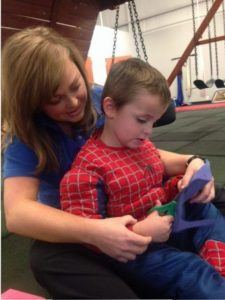
____Cuts a square
____Folds a piece of paper in half
____Able to copy a couple letters (usually their name)
____Ties shoes
____Read and write numbers 1-5
____Trace letters
Shoe tying is quite challenging for some children to learn. See our blog on shoe tying for more details. Here are a few tips:
*Plan ahead and leave extra time to practice tying shoes when your child truly needs to put them on
*Be sure that you only purchase shoes with ties after about age 4 – 4 1/2 showing your child that this is the age they should start learning to tie.
*Have another child/sibling model for the child learning to tie
*Practice first on a shoe that is NOT on their foot but position the shoe in front of the child as if it is on their foot. This encourages the correct hand positioning and directs the vision down versus out like in tying a shoe on a foot.
If your child is not mastering the above skills by age 5 or after a couple months of encouraging by you now that you have the knowledge, please contact their pediatrician for advice. ABC’s Occupational Therapists love to teach parents tips/tricks to help their children to maximize their potential. Let us know if we can help!
Read More
Typical Development of Dressing Skills
By age 2 your child should:
- Begin to push arms through sleeves of a shirt
- Take off his socks, shoes, and hat
- Lift a leg to help pull pants up
- Begin to pull down own pants
By age 3 your child should:
- Take off own coat
- Remove loose elastic waist pants
- Dress self in shirt with buttons on the front (does not button at this age)
- Unzip a zipper
- Unbutton large buttons

By age 4 your child should:
- Undress removing tops and pants
- Dress self in t-shirts or sweaters with some assistance
- Put on pants with assistance to zipper/button the pants
- Able to fasten large buttons without assistance
- Pull up zipper on jacket once it is started
- Put on shoes and socks (not yet able to tie shoes)
By age 5 your child should:
- Be able to tie own shoes
Now you are armed with the information you need to encourage your child to dress themselves. Spend a couple months really empowering independence with dressing. It will build self confidence!
If, after 2 months of trying, your child is not mastering the above skills at their age level, please reach out to your pediatrician. Occupational Therapists at https://www.abcpediatrictherapy.com would love to help you to help your child learn dressing skills. Children that can dress by themselves decreases frustration in the home and saves time.
Read MoreYou ever get the feeling that young moms are relying more on the internet for advice than that of their pediatrician?
I was amazed when my younger sister (and new mom) showed me this article that an “expert” mom posted in one of her online mom groups about why tummy time is bad for your baby. I certainly got a little fired up about it, but I also gained a better understanding of information that is being presented to young parents today, now that my children are older and I am out of that “circle”. http://www.deliberateparenting.net/2012/02/01/three-good-reasons-to-not-do-tummy-time/.
As you know we have our rebuttal of the many reasons why tummy time is important: strength of the hands for fine motor control, sensory integration, bilateral coordination, vision, strength, and so on…
A study published by Developmental Medicine and Child Neurology in 2009 investigated if children with torticollis (tight neck muscles) where more likely to have delays in their motor skills. They found that “the CMT (children with Cervical Musculature Torticollis – tight neck muscles) group achieved early motor milestones significantly later than the control group until the age of 10 months, but the risk of delay seems to be more strongly associated with little or no time prone when awake than with CMT”. They also found that “only about one-fifth of the infants spent at least three times a day in the prone position when awake at this age [2 months]” http://onlinelibrary.wiley.com/doi/10.1111/j.1469-8749.2008.03195.x/full
Let’s face it, in our busy world, babies are given less opportunity for playing on their belly than they used to.
Are there kids who never had tummy time who develop perfectly fine. Of course! The challenge is we can’t see into the future lives of our children and we can’t go back and do it over again. I was treating an infant for torticollis and plagiocephaly (flat shaped head)and the mom told me, “My pediatrician told me I should put her on her tummy to play, but I didn’t know what could happen if I didn’t”.
I want to hear less parents say, “I wish I had known”.
There is no doubt that it can be a struggle for new moms who are trying to do all the right things for their new baby while getting conflicting advice. If tummy time is easier, the conflict would not exist and we would have happy babies playing and developing on their tummies!
written by Sarah King, PT, MPT
 Skip to content
Skip to content
